|
This article has appeared previously with Equestrian Life. To see what's in the current issue, please click here
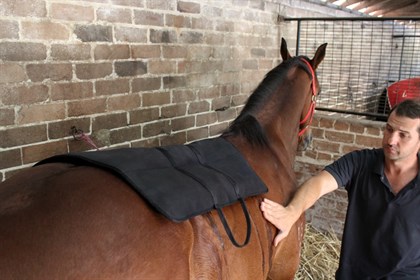
You will be surprised to see how quickly your horse relaxes with the ice on their back. Image: Tom Simpson.
Cooling the engine room
By Tom Simpson
Athletes have been using ice as a therapy for soft-tissue injuries and pain relief for centuries, so it is little wonder the big chill treatment is proving a boon in helping athletic horses recover.
Cold treatments for injuries or sore muscles after exercise is an ingenious method for reducing pain and swelling and promoting faster healing. Using ice as a treatment for soft-tissue injuries and restorative benefits has been around for hundreds of years. Ancient Egyptians were among the first to discover the invigorating benefits of submerging the body in cold water. Romans were also known to take a quick dip in icy cold rivers following battles. Later, Hippocrates of Kos, who was a Greek physician in the Age of Pericles, made significant progress in the method of cold treatment with his “water cure”. Hippocrates, who is recognised as one of the most outstanding figures in the history of medicine and the father of hydrotherapy, discovered that ice-cold water, taken internally and/or externally, proved useful in many medical cases. He often prescribed water melted from ice as the perfect treatment for relieving inflammation and pain. Ice therapy has evolved over time and has become one of the most common practices for relieving swelling and injury caused by exercise.
You will often see sports professionals standing in ice baths or the cold water of the ocean as part of their recovery regimen. For the rest of us who don’t desire going for a swim in the middle of winter, applying a pack of ice to affected muscles in order to reduce the swelling and increase the chances of a full recovery is a more sensible and effective way of treatment. The use of heat and ice for the treatment of soft-tissue injuries in equine athletic performance is now an accepted and effective method of pain relief. However, it can be confusing to decide which is more appropriate at any given time. What is commonly accepted is to use cold for acute pain or a new swollen/inflamed injury, and use heat for a chronic injury. The other rule that I tend to stick by and find very effective is to use heat prior to exercise to help warm up the muscles and increase blood flow and use cold following exercise to assist in removing any inflammation and/or pain.
It is common practice to ice a horse’s back, hind limbs and/or legs following exercise. What some of you may not know, and something that has been an invaluable addition to my treatment regimens and home management programs, is how to effectively ice a horse’s back and hind limbs. We place the back under such intense pressure, and usually at an age where bones and joints aren’t fully matured. Not to mention the fact that more often than not they are exercising under saddle, so this region is constantly exposed to stress under saddle. If you think that back soreness is apparent, I strongly recommend you contact your veterinarian first who will then consult with your local physiotherapist. Back pain can be present in many different forms and have a variety of causes so it is essential that a veterinarian has diagnosed this area before ice treatment is applied. I would also ensure that if you haven't had a regular saddle fit performed, then ensure this is done immediately. An ill-fitting saddle can cause severe back pain and any alterations made from your saddle fitter can be discussed in detail with your treating veterinarian and physiotherapist.
Picture 1: This shows the ice pack over the thoracolumbar spine. It is important to ensure the ice is level and covers the desired region effectively. When you do this for the first time stand with your horse until it is comfortable. From a safety perspective I don’t tie the ice pack on as it is important that they are able to remove it if they need to.
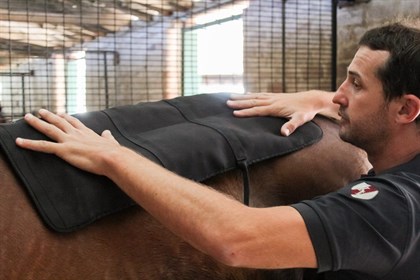
This shows the ice pack over the thoracolumbar spine. Image: Tom Simpson.
Picture 2: You will be surprised to see how quickly your horse relaxes with the ice on their back. As the ice melts the water can occasionally tickle your horse. They will adapt to this feeling after the first few times, however, it will help if you wipe away the water as I am doing here.

You will be surprised to see how quickly your horse relaxes with the ice on their back. Image: Tom Simpson.
Picture 3: After a period of about 10 minutes I will always check to see that the area is getting cold and the ice pack doesn’t have to be adjusted.
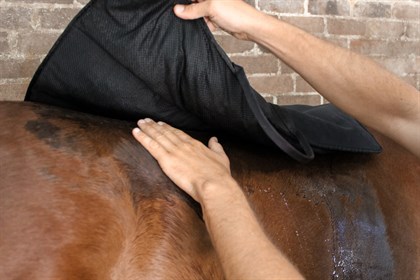
I will apply the ice pack for 20 minutes. Image: Tom Simpson.
Picture 4: I will apply the ice pack for 20 minutes. Following this I will always check that the ice has had the desired effect and that I have a happy customer!
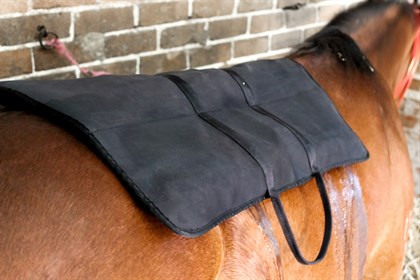
After a period of about 10 minutes I will always check to see that the area is getting cold and the ice pack doesn’t have to be adjusted. Image: Tom Simpson.
For many years icing has been an effective form of treatment in elite human athletes for acute injuries to assist in recovery for performance. It is no different for the horse. I describe the back and hind limb collectively as the engine room of the horse. Ice is such a simple, inexpensive and effective method of treatment of soft-tissue injuries and an effective method of pain relief. After years of clinical experience I know how important it is for this engine room to be pain-free and healthy.
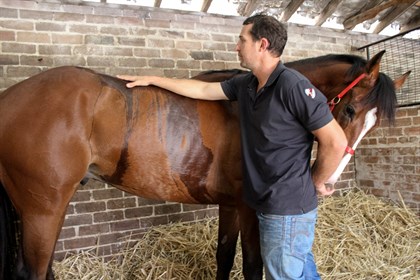
One happy cool customer. Image: Tom Simpson.
I have found that effective ice treatment can be a great way to ensure that these athletes are in their best shape to perform the discipline they require. A trip down to your local service station to pick up a bag of ice is more than enough to see results.
READ THE LATEST NEWS ARTICLES HERE

|

